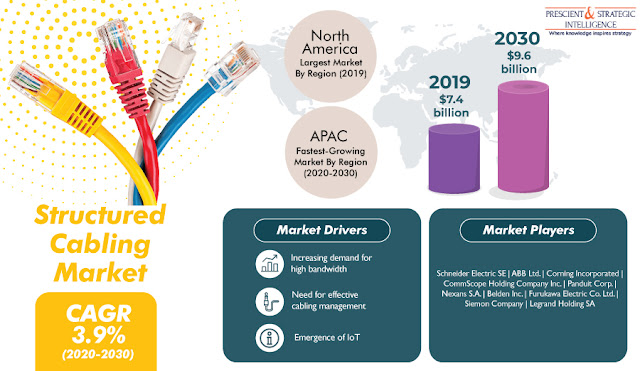The telecom industry is creating a huge requirement for structured cabling, due to the burgeoning demand for hassle-free information technology (IT) infrastructure. Structured cabling helps in effective cable management, as it can be administered and managed without the engagement of a large number of staff. Administration of structured cabling systems facilitates cost and time savings in government organizations and data centers.
In comparison to patch cords, this cabling system offers a more organized and standardized approach. Thus, the flourishing telecom sector will fuel the adoption of structured cabling in the forthcoming years. Moreover, the booming demand for high bandwidth, owing to the rising penetration of the internet, will help the structured cabling market progress at a CAGR of 3.9% during 2020–2030.
The market was valued at $7.4 billion in 2019 and it is projected to generate $9.6 billion revenue by 2030. Enterprises are increasingly modifying their IT infrastructure, due to the extensive usage of bandwidth-intensive applications, such as digital audio and video, internet protocol (IP)-based video conferencing, and voice over internet protocol (VoIP).
Adoption of structured cabling by data centers of various industries and government organizations helps in reducing the overall operational costs, which include costs associated with slow data transfer and other network failures. Furthermore, structured cabling also decreases the requirement for updates and minimizes the overall maintenance cost, as it unifies the IT network for videos, data, and voice. Owing to these advantages, enterprises with huge IT budgets are shifting from conventional cabling to structured cabling.
Thus, the surging need for higher bandwidth and the soaring demand for hassle-free IT infrastructure will augment the adoption of structured cabling products, across the world.
In comparison to patch cords, this cabling system offers a more organized and standardized approach. Thus, the flourishing telecom sector will fuel the adoption of structured cabling in the forthcoming years. Moreover, the booming demand for high bandwidth, owing to the rising penetration of the internet, will help the structured cabling market progress at a CAGR of 3.9% during 2020–2030.
Structured Cabling Market Growth Prospects, Key Vendors, and Future Scenario
Adoption of structured cabling by data centers of various industries and government organizations helps in reducing the overall operational costs, which include costs associated with slow data transfer and other network failures. Furthermore, structured cabling also decreases the requirement for updates and minimizes the overall maintenance cost, as it unifies the IT network for videos, data, and voice. Owing to these advantages, enterprises with huge IT budgets are shifting from conventional cabling to structured cabling.
Thus, the surging need for higher bandwidth and the soaring demand for hassle-free IT infrastructure will augment the adoption of structured cabling products, across the world.

Comments
Post a Comment